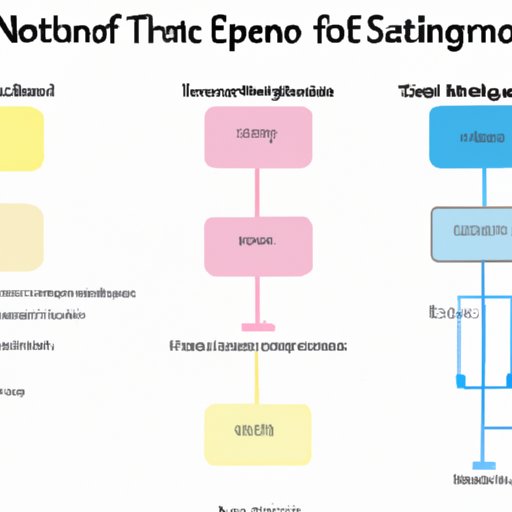Introduction
A mobile phone is an electronic device used for communication over a cellular network. It is a portable telephone that can make and receive calls over a radio frequency link while the user is moving within a telephone service area. The term “smartphone” is used to describe a mobile phone that offers more advanced computing capabilities, such as the ability to run programs and access the internet.
The purpose of this article is to explore how a mobile phone works by examining its different components and technologies. From a detailed description of the hardware and software components to an overview of the different operating systems used in smartphones, this article will provide a comprehensive guide to understanding the inner workings of modern mobile phones.
Explaining the Different Components of a Mobile Phone and How They Work Together
Modern mobile phones are made up of both hardware and software components. These components work together to enable the user to make and receive calls, take photos, browse the internet, and access a variety of other features.
Hardware Components
The hardware components of a mobile phone include the battery, display, processor, memory, camera, network connection, and sensors. Each component plays an important role in the functioning of the mobile phone.
The battery is the power source of the mobile phone. It is responsible for supplying power to all the other components. The display is the screen of the phone. It is used to view images, videos, and text. The processor is the brain of the phone. It is responsible for running applications and performing other tasks. The memory is used to store data such as photos, music, and videos. The camera is used to take photos and record videos. The network connection is used to connect the phone to the internet or another device. Lastly, the sensors are used to detect movement, temperature, and other environmental factors.
Software Components
The software components of a mobile phone include the operating system and applications. The operating system is the software that controls the hardware components and runs applications. Popular operating systems used in smartphones include Android, iOS, and Windows Phone.
Applications are programs that allow users to perform specific tasks such as playing games, checking email, or managing finances. Applications are downloaded from app stores such as the Google Play Store or Apple App Store.

An Overview of the Different Operating Systems Used in Smartphones
Android is the most popular mobile operating system. It is developed by Google and is based on the Linux kernel. Android is open-source, which means it can be modified by device manufacturers and developers to create custom versions. It is used in a wide range of devices, from smartphones to tablets.
iOS is the second most popular mobile operating system. It is developed by Apple and is only used in Apple devices such as iPhones and iPads. iOS is known for its sleek design, ease of use, and strong security features.
Windows Phone is the third most popular mobile operating system. It is developed by Microsoft and is used in some Nokia and HTC devices. Windows Phone is known for its integration with other Microsoft services such as Outlook and Skype.

A Guide to Understanding the Different Network Technologies Used in Phones
Network technologies are used to transmit data between devices. There are several different network technologies used in phones, each offering different speeds and coverage areas.
2G/GSM is the oldest network technology used in phones. It is used primarily for voice calls and text messages and has limited data transfer capabilities. 3G/UMTS is the next generation of network technology. It provides faster data transfer speeds and is used for streaming music and watching videos. 4G/LTE is the latest network technology. It provides even faster data transfer speeds and is used for downloading large files and using high-bandwidth applications such as video conferencing. 5G is the newest network technology. It is still in development but promises to offer even faster data transfer speeds.
Exploring the Role of Apps in Mobile Phone Functionality
Apps are an important part of mobile phone functionality. They allow users to perform specific tasks such as playing games, checking emails, or managing finances. Apps can be downloaded from app stores such as the Google Play Store or Apple App Store.
There are many different types of apps available, from productivity apps to entertainment apps. Some apps are free to download, while others must be purchased. It is important to be aware of the security risks associated with downloading apps. Malware and viruses can be hidden in malicious apps, so it is important to only download apps from trusted sources.

Investigating the Impact of Mobile Technology on Everyday Life
Mobile technology has had a profound impact on everyday life. It has changed the way we communicate, shop, entertain ourselves, and interact with the world around us.
Social media has become a major part of our lives, allowing us to stay connected with friends and family around the globe. Mobile phones have enabled us to stay connected anytime, anywhere. We can access the internet, send emails, and make calls from almost any location.
Shopping has been transformed by mobile technology. We can now shop online from the comfort of our own homes or on the go. We can compare prices, read reviews, and purchase items with just a few taps of the screen.
Lastly, mobile technology has revolutionized entertainment. We can watch movies, play games, and listen to music on our phones. We can also access a wealth of information on the internet, from news articles to educational resources.
Conclusion
In conclusion, this article has explored how a mobile phone works by examining its different components and technologies. From the hardware components to the software applications, this article has provided a comprehensive guide to understanding the inner workings of modern mobile phones. It has also looked at the different types of network technologies used in phones and the role of apps in mobile phone functionality, as well as the impact of mobile technology on everyday life.
(Note: Is this article not meeting your expectations? Do you have knowledge or insights to share? Unlock new opportunities and expand your reach by joining our authors team. Click Registration to join us and share your expertise with our readers.)
